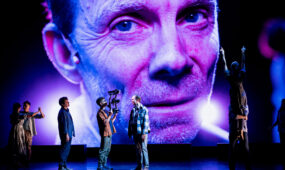Music born of Vietnam's war wounds
Festivals
Hanoi musicians whose songs reflect the scars of the Vietnam War era will bring their unique sound to WOMADelaide in what Grammy-winning American producer Ian Brennan promises will be a “virtuosic” performance.

Brennan, also the producer for the Malawi Mouse Boys, travels around the world looking for interesting musicians and the Hanoi Masters ensemble was created after he visited Vietnam with his filmmaker wife seeking out recording artists who had survived the war.
The album Hanoi Masters: War is a Wound, Peace is a Conflict was released on the 40th anniversary of the end of the conflict and features songs written in direct response to the suffering caused by the war, as well as haunting adaptations of traditional Vietnamese songs.
But despite their stoicism, says Brennan, the Masters bring joy, humour and a surprising liveliness to their shows.
Below, he explains more about the project, the Vietnamese musicians, and what WOMADelaide audiences can expect from the performances by the Hanoi Masters, under the leadership of musical director, percussionist and zither player Vân-Ánh Võ.
What prompted your trip to Vietnam to search for recording artists who had survived the war?
I was working in the psychiatric emergency room for Oakland, California, and in the 1980s and 1990s we witnessed daily the ravages of many veterans – homelessness, addiction, post-traumatic stress disorder. At the same time, there was a plethora of Vietnam War films (Platoon, Full Metal Jacket, et al) and the post-Vietnam anthem “Born in the USA” seemed to be on endless loop.
One day I was interviewing one veteran and suddenly I realised that there must be similar, if not worse (since it occurred on their own homeland), suffering mirrored from the other side.
As with all of the projects that my wife, Marilena Delli (who does all of the photos and video that accompany these albums) and I have done in countries like Rwanda, Malawi, South Sudan, etc, the record was an attempt to listen closely to those that have been ignored, silenced or under-heard.

Ian Brennan recording in the field.
What can you tell us about the experiences of the musicians you ended up working with?
Every one of them has a profound and very personal story, much of which is ineffable. And that is where music comes in, as it helps bridge language differences and to pick up and extend communication at the point where words fail.
Võ Tuấn Minh was a soldier and his primary job was as a musician who would console the troops in the camp.
Nguyễn Thị Lân was a village leader at the very young age of 20 and part of that responsibility was being issued an AK-47. She hadn’t sung for 40 years.
How different is their perspective on the Vietnam War to that which we are used to hearing and seeing through Western music and film?
Quite revealingly, they refer to it as “the American War”.
For them, the conflict does not hold quite the same significance that it does for the USA. There are two primary reasons for this: firstly, the American-Vietnam war was the first that the US ever “lost”, and secondly, Vietnam suffered such a string of battles – China, Japan, France – that sadly, this horrible war just has to stand in line in a long line of invaders and the suffering that occurred in their wakes.
What are some of the traditional Vietnamese instruments and techniques used by the Hanoi Masters musicians?
Xuân Hoạch is actually a prolific instrument builder, as are many of the other masters. His home is stuffed to the roof with various one-of-a-kind pieces.
Quôć Hùng plays the K’ni [a one-stringed instrument clasped between the teeth and often described as a mouth violin] – it is extremely rare and endangered and sounds absolutely extraterrestrial, all without the aide of any electricity. And whammy bars – a technology that dates back to the 9th century there – are found on many of the instruments.

Quôć Hùng playing the K’ni.
Vietnamese culture had a massive head start on 1980s Sunset Strip hair-metal wankers and the surf guitar genre.
Also, sound modification like distortion has been valued in their traditions for thousands of years.
War is a Wound – Peace is a Scar is described as an album of “cautious healing” … what is meant by this?
The myth that we’re sold is that epiphanies can occur and through those miracles we can suddenly get over loss completely, once and for all. This idea does a horrible disservice to victims, by setting up unreasonable expectations and even demands.
A more balanced and realistic model is progress versus perfection – that with major traumas, we may never get over them completely. There may simply not be enough time to digest certain events and losses in a single lifetime.
And healing can actually be aided by recognising and respecting, but not wallowing in the magnitude of the hurt.

Get InReview in your inbox – free each Saturday. Local arts and culture – covered.
Thanks for signing up to the InReview newsletter.
What kind of experience can WOMADelaide audiences expect from the Hanoi Masters’ live performance?
Virtuosic! Vân-Ánh Võ [Hanoi Masters musical director, percussionist and zither player] is a simply incredible musician. She guests with many symphonies around the world and is a frequent collaborator of the Kronos Quartet.
Also, there is a great humor and joy that they bring to what they are doing. They may have a dry wit, but beneath that stoicism, there is tremendous complexity, insight and mischief.
Far from the awful stereotype of “passive”, I think many people will be pleasantly surprised just how rocking they can be when they choose to.
WOMADelaide runs from March 10-13 in Botanic Park.
Support local arts journalism
Your support will help us continue the important work of InReview in publishing free professional journalism that celebrates, interrogates and amplifies arts and culture in South Australia.
Donate Here





Comments
Show comments Hide comments